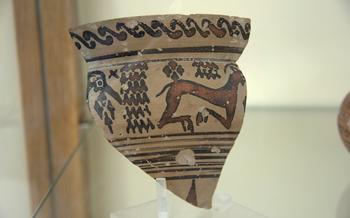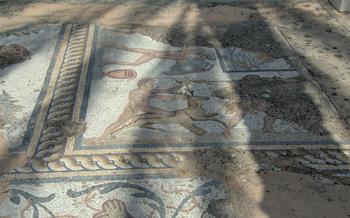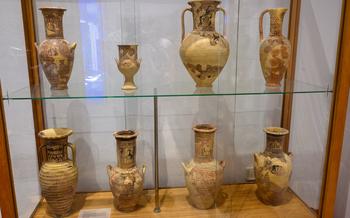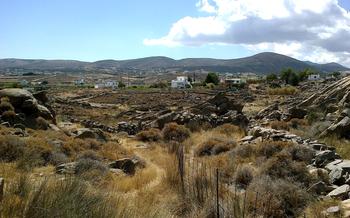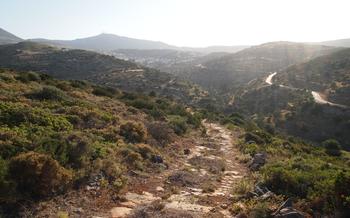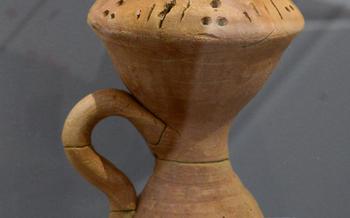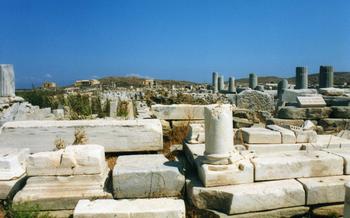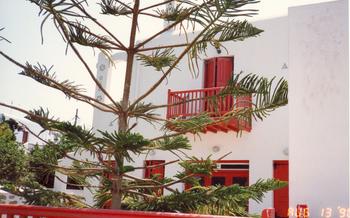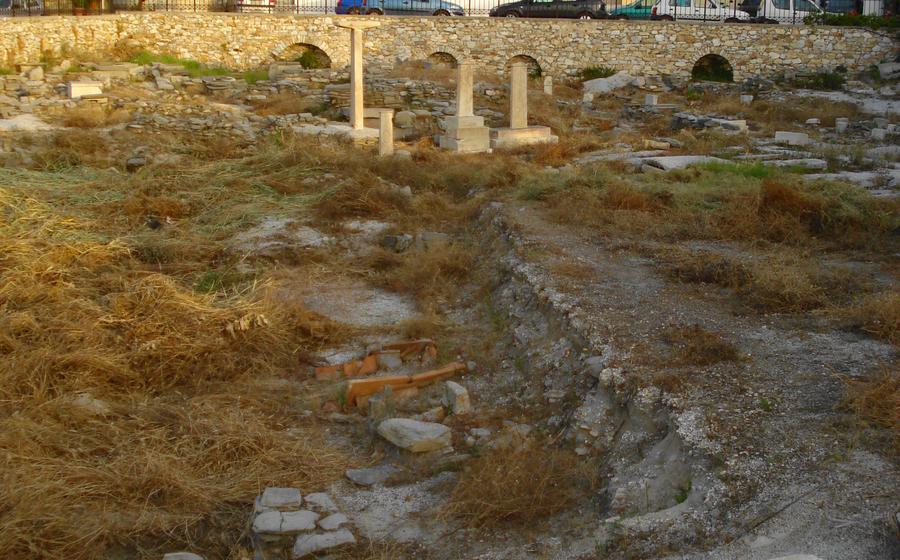
Paros Ancient Cemetery
- Historical Background
- Location and Accessibility:
- Types of Tombs
- Epitaphs and Inscriptions
- Funerary Objects
- Excavations and Discoveries
- Chronological Overview
- Cultural Significance
- Museum Exhibits
- Guided Tours
- Visitor Tips
- Photography and Videography
- Accessibility for Disabled Visitors
- Insider Tip: Unraveling the Secrets of the Ancient Theater
Historical Background
The Paros Ancient Cemetery, nestled in the heart of the picturesque Greek island of Paros, offers a fascinating glimpse into the island's rich cultural heritage and ancient history. Established in the 6th century BC, the cemetery served as a sacred burial ground for the inhabitants of the ancient city of Paros. Its significance lies not only in its antiquity but also in its well-preserved state, providing a tangible connection to the funerary practices and customs of ancient Greece.
The island of Paros, renowned for its pristine beaches, white-washed villages, and exquisite marble, has a storied history dating back to the Bronze Age. Its strategic location in the Aegean Sea transformed it into a thriving maritime and commercial center, attracting diverse influences from neighboring civilizations. These influences, coupled with the island's own unique cultural identity, shaped the development of the Paros Ancient Cemetery, making it a testament to the island's rich past.
In ancient Greece, burial practices held deep religious and social significance. The Paros Ancient Cemetery reflects these beliefs and customs, showcasing a variety of tomb types and funerary objects that provide insights into the ancient Greek concept of the afterlife. The cemetery's enduring presence serves as a poignant reminder of the deep respect and reverence with which the ancient Greeks honored their deceased loved ones.
Location and Accessibility:
The Paros Ancient Cemetery, a significant historical site on the beautiful island of Paros, is situated near the village of Marathi, offering easy access for visitors. To reach the cemetery, take the main road leading out of Parikia, the island's capital, towards Marathi. Follow the signs indicating the cemetery's location, and within a short drive, you will arrive at the entrance.
The cemetery is conveniently situated in proximity to other popular attractions in Paros. A short distance away is the famous Marathi Beach, known for its crystal-clear waters and golden sands. Visitors can combine their visit to the cemetery with a refreshing swim and sunbathing session, creating a well-rounded experience.
Transportation to the Paros Ancient Cemetery is readily available. Regular bus services operate from Parikia and other parts of the island, making it easy for visitors to reach the site. Additionally, taxis are available for those who prefer a more direct and convenient mode of transport.
Types of Tombs
The Paros Ancient Cemetery showcases a diverse array of tombs, each reflecting the social status and cultural beliefs of the ancient Greeks. The most common type of tomb is the cists grave, a simple rectangular pit lined with stone slabs. These graves were typically used for the burial of infants and children. For adults, there are larger sarcophagi, stone coffins with elaborate carvings and decorations. Wealthy and prominent individuals were often buried in chamber tombs, which consisted of multiple rooms and could accommodate several burials. These tombs were often adorned with frescoes, mosaics, and sculptures, providing valuable insights into ancient Greek art and funerary practices. Additionally, there are heroic tombs, which were built for individuals who were considered heroes or had achieved great deeds. These tombs were often located in prominent positions within the cemetery and were designed to honor and commemorate the deceased.
Epitaphs and Inscriptions
The Paros Ancient Cemetery is a treasure trove of epitaphs and inscriptions that offer a glimpse into the lives and beliefs of the ancient Greeks. These inscriptions, carved on tombstones and monuments, serve as poignant reminders of the individuals buried there and provide valuable insights into their social status, family relationships, and personal qualities.
One particularly touching epitaph reads, "Here lies Kallirhoe, the beloved wife of Nikandros. She was a kind and gentle soul, always ready to help those in need. She will be forever remembered for her love and compassion." This inscription not only commemorates Kallirhoe's life but also sheds light on the importance of compassion and kindness in ancient Greek society.
Another inscription, found on a grand mausoleum, reads, "To the memory of Archon, a brave warrior and a wise ruler. He led our city to victory in many battles and was loved and respected by all who knew him." This inscription highlights the importance of military prowess and leadership in ancient Greece, as well as the deep respect accorded to those who served their community with honor and distinction.
By studying the epitaphs and inscriptions in the Paros Ancient Cemetery, we can gain a deeper understanding of the lives, values, and beliefs of the ancient Greeks. These inscriptions are a testament to the enduring power of the human spirit and a reminder of the importance of preserving our cultural heritage.
Funerary Objects
The Paros Ancient Cemetery is a treasure trove of funerary objects, providing valuable insights into the beliefs and customs of the ancient Greeks. These objects, buried alongside the deceased, served various purposes, ranging from practical to symbolic.
Practical Objects:
Among the most common funerary objects found in the cemetery are pottery vessels, such as amphorae, jugs, and cups. These vessels likely contained food and drink offerings for the deceased, ensuring their sustenance in the afterlife. Additionally, jewelry, such as necklaces, bracelets, and earrings, was often buried with the dead, symbolizing their status and wealth in the next world.
Symbolic Objects:
Figurines and statuettes depicting deities, heroes, or animals were also common funerary objects. These figurines represented the divine protection and guidance sought for the deceased in the afterlife. Weapons, such as swords, spears, and shields, were buried with warriors and symbolized their valor and strength.
Personal Objects:
Personal objects, such as tools, toys, and clothing, were also found in the tombs. These objects reflected the individual's occupation, interests, and identity, accompanying them into the afterlife.
The presence of these funerary objects in the Paros Ancient Cemetery offers a glimpse into the beliefs and practices of the ancient Greeks, who believed in providing for the deceased in their journey to the next world.
Excavations and Discoveries
The Paros Ancient Cemetery has been the subject of several excavations over the years, shedding light on the rich history and cultural significance of the site. In the early 20th century, the Greek Archaeological Service conducted extensive excavations that uncovered numerous well-preserved tombs and a variety of artifacts, including pottery, jewelry, and weapons. These excavations provided valuable insights into the burial customs and practices of the ancient Greeks.
In recent years, renewed interest in the cemetery has led to additional excavations and discoveries. In 2010, a team of archaeologists from the University of Athens uncovered a remarkably intact family tomb dating back to the 5th century BC. The tomb contained a wealth of artifacts, including gold jewelry, bronze vessels, and ceramic vases, providing a glimpse into the lives and customs of an ancient Paros family. These ongoing excavations continue to uncover new information and artifacts, adding to our understanding of this ancient burial ground.
Chronological Overview
The Paros Ancient Cemetery holds a rich and diverse history spanning several centuries. Its establishment dates back to the 7th century BC, marking the beginning of an era when Paros flourished as a maritime and commercial power. During this period, the cemetery served as the primary burial ground for the island's inhabitants, reflecting the growing population and prosperity of Paros.
The 5th century BC witnessed a significant expansion of the cemetery, coinciding with the rise of the Delian League. This period saw the construction of elaborate tombs and mausoleums, adorned with intricate carvings and sculptures, showcasing the artistry and craftsmanship of the ancient Greeks. The tombs of this era often featured multiple chambers and were designed to accommodate entire families, reflecting the strong emphasis on familial bonds and lineage.
The 4th century BC marked a period of transition and change in the Paros Ancient Cemetery. With the decline of the Delian League, Paros experienced a shift in its political and economic fortunes. As a result, the cemetery saw a decrease in the construction of new tombs, and existing ones were often reused for multiple burials. This practice, known as secondary burial, reflects the changing social and economic conditions of the time.
By the 3rd century BC, the Paros Ancient Cemetery had reached its peak, with thousands of tombs covering a vast area. However, the following centuries witnessed a gradual decline in burials, as the island's population shifted towards other parts of Paros and the surrounding region. The cemetery was eventually abandoned around the 1st century AD, marking the end of an era that had witnessed the evolution of ancient Greek burial practices and customs.
Cultural Significance
The Paros Ancient Cemetery holds immense cultural significance as a reflection of ancient Greek civilization and its rich funerary traditions. It offers a glimpse into the religious beliefs, social customs, and artistic expressions of the ancient Greeks. The cemetery's well-preserved tombs, inscriptions, and funerary objects provide valuable insights into the lives and deaths of individuals from various social and economic backgrounds.
The variety of tomb types, ranging from simple graves to elaborate mausoleums, showcases the social stratification and cultural diversity of ancient Greek society. The epitaphs and inscriptions on the tombs reveal personal stories, family relationships, and achievements of the deceased, offering a glimpse into their lives and legacies.
Furthermore, the cemetery's location on the sacred island of Paros, known for its marble quarries and artistic heritage, adds to its cultural significance. The use of local marble in the construction of tombs and sculptures demonstrates the importance of craftsmanship and the deep connection between art and death in ancient Greek culture.
Preserving and protecting the Paros Ancient Cemetery is crucial for safeguarding this valuable cultural heritage. It serves as a reminder of the rich history and traditions of ancient Greece, offering contemporary society a deeper understanding of the beliefs, customs, and artistic expressions of one of the world's most influential civilizations.
Museum Exhibits
The cultural significance of the Paros Ancient Cemetery is further enhanced by the existence of museum exhibits that showcase artifacts and information related to the site. The Paros Archaeological Museum, located in the capital city of Parikia, houses a significant collection of artifacts from the cemetery, including pottery, jewelry, and funerary objects. These exhibits provide a deeper understanding of the burial practices and customs of the ancient Greeks, as well as the artistic and cultural traditions of the period.
The exhibits at the Paros Archaeological Museum are well-organized and informative, with detailed descriptions and explanations of the artifacts on display. Visitors can learn about the different types of tombs found in the cemetery, the significance of the funerary objects, and the lives of the individuals buried there. The museum also offers guided tours that provide expert insights into the history and cultural significance of the Paros Ancient Cemetery.
Guided Tours
Exploring the Paros Ancient Cemetery with a knowledgeable guide can significantly enhance your experience and understanding of this ancient site. Guided tours are available for visitors who seek a deeper insight into the history, significance, and cultural context of the cemetery.
Led by experienced professionals, these tours offer a personalized and informative journey through the ancient burial ground. Guides share fascinating stories and anecdotes about the individuals buried here, providing a glimpse into their lives and the society they lived in.
With a guided tour, you'll gain a deeper appreciation for the architectural features, funerary objects, and inscriptions found in the cemetery. Guides can explain the symbolism and significance of these elements, helping you understand the ancient Greek beliefs and practices surrounding death and the afterlife.
Booking a guided tour is easy and can be arranged through local tour operators or directly at the cemetery. Tours typically last for around an hour and a half and are available in multiple languages. Prices vary depending on the tour operator and group size, but generally range from 15 to 25 euros per person.
Whether you're a history buff, an archaeology enthusiast, or simply someone with a curiosity for ancient cultures, a guided tour of the Paros Ancient Cemetery is an enriching and unforgettable experience.
Visitor Tips
-
When planning your visit to the Paros Ancient Cemetery, consider the time of day and season to ensure the most enjoyable experience. The early morning or late afternoon hours offer pleasant temperatures and fewer crowds, allowing you to explore at your own pace.
-
Dress appropriately for the weather and terrain. Comfortable shoes are essential for navigating the uneven ground and exploring the cemetery's many paths.
-
Bring a camera to capture the unique features of the cemetery, such as the elaborate tombs, inscriptions, and funerary objects. However, be mindful of any photography restrictions or guidelines that may be in place.
-
Stay hydrated by bringing a bottle of water, especially if visiting during the warmer months. The cemetery offers limited shade, so it's essential to stay refreshed and protected from the sun.
-
Be respectful of the historical significance of the cemetery. Avoid climbing on the tombs or disturbing the artifacts and inscriptions. Remember that these are the final resting places of ancient individuals, and we should treat them with reverence.
Photography and Videography
Photography enthusiasts and videographers are welcome to capture the beauty and significance of the Paros Ancient Cemetery through their lenses. However, it is essential to be respectful of the solemn nature of the site and to adhere to the following guidelines:
-
Flash Photography: The use of flash photography is generally discouraged within the cemetery to avoid disturbing the ambiance and potentially damaging delicate artifacts.
-
Tripods: The use of tripods is permitted, but visitors are requested to be mindful of other visitors and to avoid obstructing pathways or causing inconvenience.
-
Filming Permits: Filming for commercial purposes may require a permit from the relevant authorities. Visitors are advised to inquire about the necessary permits and regulations before filming within the cemetery.
-
Respect for Privacy: Visitors should be respectful of the privacy of other visitors and avoid capturing images or videos that may be intrusive or disrespectful.
By following these guidelines, visitors can ensure that they capture the essence of the Paros Ancient Cemetery while respecting its historical and cultural significance.
Accessibility for Disabled Visitors
The Paros Ancient Cemetery is committed to providing an accessible and enjoyable experience for all visitors, including those with disabilities. The site features wheelchair-accessible paths and ramps, ensuring that visitors can navigate the cemetery with ease. For those who require additional assistance, wheelchairs are available upon request at the entrance. Visitors with visual impairments can benefit from guided tours that provide detailed descriptions of the cemetery's features and history. Furthermore, the museum exhibits related to the cemetery offer accessible displays and information in various formats, catering to visitors with different needs. By ensuring accessibility, the Paros Ancient Cemetery allows everyone to explore and appreciate this significant cultural heritage site.
Insider Tip: Unraveling the Secrets of the Ancient Theater
Amidst the ruins of the Paros Ancient Cemetery, nestled between ancient tombs and weathered mausoleums, lies a hidden gem that often goes unnoticed by visitors. It's an ancient theater, a relic of a bygone era when tragedy and comedy unfolded on its stage. Carved into the hillside, the theater offers a breathtaking view of the surrounding landscape, with the deep blue Aegean Sea stretching out beyond.
To find this hidden treasure, venture off the main path and follow the winding trail that leads uphill. As you approach the theater, you'll be transported back in time, imagining the echoes of ancient performances reverberating through the stone seats. Take a moment to sit and soak in the ambiance, letting your mind wander to the days when this theater was filled with laughter, tears, and applause.
While the theater may be in ruins, its spirit remains alive. Close your eyes and listen closely, and you might just hear the faint whispers of ancient actors reciting their lines or the roar of the crowd cheering their favorite performers. This hidden spot is a testament to the enduring power of the arts and a reminder that even in the midst of decay, beauty and creativity can still be found.


